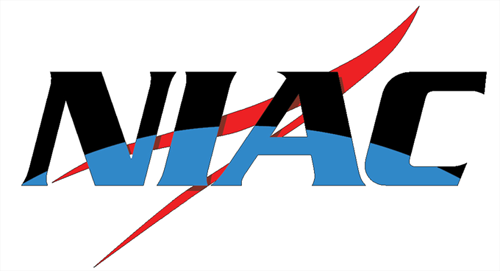NASA in search of innovative ideas

On June 5, NASA released the results of the first phase of the NASA Innovative Advanced Concepts (NIAC) program for fiscal year 2014.
The goal of NIAC is to collect revolutionary ideas that will make great leaps in the development of the aerospace industry.
As a result of the competition, 12 concepts were selected, including 3 works from the Jet Propulsion Laboratory (NASA).
')
Read about the winners of the first stage below, and now a little about NIAC.
What is NIAC
In the mid-90s, at NASA headquarters, on the basis of the Department of Aerospace Technologies, it was decided to contact people outside the agency to search for new ideas. So, in 1998, the NASA Institute of Advanced Concepts was created, which existed until 2007, and for 9 years of work it collected 1309 proposals, of which 168 were supported financially.
In 2008, NASA planned to resume the exploration of the Moon and considered the possibility of resuscitation of NIAC to provide ideological support for its plans. But one desire was not enough, and Congress instructed the National Research Council (National Research Council) to evaluate previous activities and make recommendations to improve the performance of NIAC.
The research report followed in 2009 and, on the one hand, contained extremely positive characteristics, recommendations for creating such an institution, and on the other hand, several proposals for optimizing the structure.
In 2010, NIAC was revived, but it was no longer a separate institution, but a part of the NASA Space Technology Program.
Currently, the NASA Innovative Advanced Concepts (NIAC) program remains part of the Space Technology Mission Directorate (STMD) and continues to accumulate innovative ideas that can one day change the boundaries of the possible.
General structure of the program
Every year, the program opens its virtual doors to everyone, and only US residents can receive funding from NASA.
The aggregation of ideas is carried out with the help of:
NASA Solicitation and Proposal Integrated Review and Evaluation System (NSPIRES)
NIAC consists of two phases:
Phase 1 lasts 9 months and consists of two parts.
Part A is the collection of brief descriptions of projects that meet the requirements of the program and the selection of the most promising of them for more detailed consideration in Part B.
Part B finalists receive funding of $ 100,000 for further research.
Phase 2 lasts 2 years and is available only to those who created or developed their concept based on the research in Phase 1.
Works in Phase 2 are subject to stringent filtering in accordance with established criteria.
NASA gives Phase 2 winners $ 500,000 more for in-depth research.
Some statistics
The cakes below show the breakdown of awards and investment amounts to recipients for the period 2011-2013.
And in the table there is also a breakdown into phases and fiscal years.

Academia - ideas from representatives of scientific institutions.
NASA - ideas from NASA employees (for example, Jet Propulsion Laboratory)
Industry / Other - other organizations / individuals.
Statistics from Nasa Innovative Advanced Concepts Publication
Phase 1 2014
This year, 12 projects were finalists of the first stage of the program, including such fantastic ideas as:
- Submarine for the study of methane lakes on Titan (satellite of Saturn).
- Using Neutrino to study the ice moons (Europe, Guinemed).
- The concept of a safe capture of an asteroid, rock fragments and other objects.
This year, the works of the finalists represent three of the eight key technological directions of the Space Technology Mission Directorate (STMD): maintaining a developed life and utilization of resources, space robotic systems and space observation systems.
The selected works also influence NASA research in the field of the study of asteroids and external planetary missions.
Ideas winners
1. Swarm Flyby Gravimetry
Instead of an orbital satellite or an expensive surface probe, send a small, economical space probe to the asteroid / comet to study the gravitational field, the internal composition and structure of the object of study.
2. Mars Ecopoiesis Test Bed
Isolating a small area of Martian soil, introducing Terrestrial bacteria into the soil to test the possibility of Mars terraforming.
3. The Aragoscope: Ultra-High Resolution Optics at Low Cost
The new space telescope allows you to get 7cm resolution of the planet's surface from its orbit or images of the sky with a resolution 1000 times greater than the resolution of the Hubble telescope.
4. 3D Photocatalytic Air Processor for Dramatic Reduction of Life Support Mass & Complexity
Compact and simple oxygen generator (for installation at space stations), with the possibility of 3D printing directly in space.
5. WRANGLER: Capture and De-Spin of Asteroids and Space Debris
Safe device for capturing and manipulating asteroids.
6. Titan Aerial Daughtercraft
Flying apparatus for the study of chemical processes on Titan.
7. Using the Icy Solar System Worlds Using the Hottest Particles in the Universe to Probe
A method of measuring the thickness of the ice cover on the ice moons (Europe, Ginimed).
8. PERISCOPE: PERIapsis Subsurface Cave OPtical Explorer
The method of optical study of lunar caves.
9. Titan Submarine: Exploring the Depths of Kraken
Submarine to explore the seas on Titan.
10. Comet Hitchhiker: Harvesting Kinetic Energy
The method of moving a spacecraft using a cometary harpoon, uses the energy of a comet to accelerate.
11. Exploration Architecture with Quantum Inertial Gravimetry and In Situ ChipSat Sensors
The study of planets using ChipSat sensors.
12. Heliopause Electrostatic Rapid Transit System (HERTS)
The method of reaching the heliopause by a spacecraft in less than 10 years, which is 27 years less than the time to reach the heliopause with the Voyager 1 probe.
Sources:
NIAC official website
NIAC funded research portfolio
Nasa Innovative Advanced Concepts Publication
Press release 14-154 of 06/05/2014
Thanks for attention.
Source: https://habr.com/ru/post/225673/
All Articles